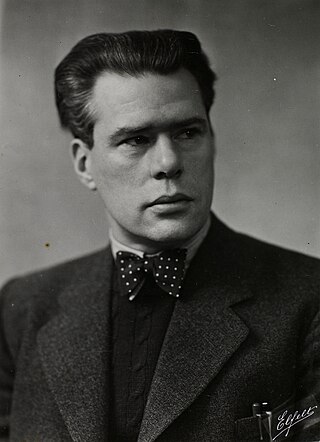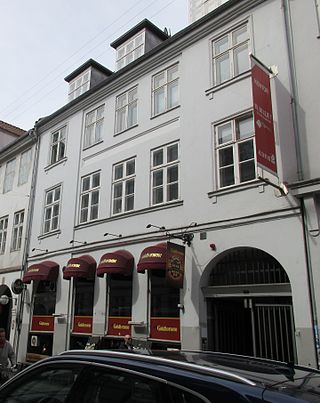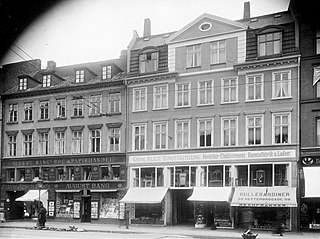Gallery
- The Stengade wing
- The courtyard wing
Rud. Rasmussen, also known as Rud. Rasmussens Snedkerier, was a manufacturer of wooden furniture based in Copenhagen, Denmark. The workshop was founded by Rudolph Rasmussen in 1869 and collaborated with some of the leading Danish furniture designers of the 20th century. Its former furniture factory at Nørrebrogade 45 was listed on the Danish registry of protected buildings and places in 2008.
Rudolph Rasmussen was born into a family of joiners in 1838. He was granted citizenship as joiner in 1869 and established his own workshop. [1]
The workshop specialized in artistically designed oak tree furniture. In the mid-1870s, it was destroyed by fire while working on furniture for the new Hotel D'Angleterre. [2]
Two of Rasmussen's sons, Rudolph and Victor (1882–1955), both joined the company and took on the operations after their father's death in 1904. Rudolph Rasmussen Jr. served as manager while his brother ran the workshop. Rudolph Rasmussen was active in the company until his death. He was succeeded by his sons Aage (born 1911) and Erik (born 1915). [1]
In the 1920s, Rud Rasmussen began to collaborate with architects such as Kaare Klint (from 1925) and Mogens Koch.. [3] It later also collaborated with Lagens Lassen, Børge Mogensen and Hans Wegner.
Alexander Schleicher was a German pioneer of sailplane design. The company that he founded and which bears his name - Alexander Schleicher GmbH & Co - is today one of the world's leading sailplane manufacturers.

Marienborg, a mid 18th-century country house perched on a small hilltop on the northern shore of Bagsværd Lake, Lyngby-Taarbæk Municipality, 15 kilometres (9.3 mi) north of downtown Copenhagen, has served as the official residence of Denmark's prime minister since 1962. It is frequently used for governmental conferences, summits and other official purposes, including the prime minister's new year speech. Unlike the residences of many other heads of government and state, Marienborg does not serve as the government headquarters or contain the office of the prime minister. The Prime Minister's Office is instead located in Christiansborg on Slotsholmen in downtown Copenhagen. Marienborg was listed on the Danish registry of protected buildings and places in 1964.

Nørrebrogade is the principal shopping street of the Nørrebro district of Copenhagen, Denmark. It runs from The Lakes in the southeast to Nørrebro station in the northwest, linking Frederiksborggade and Queen Louise's Bridge with Frederikssundsvej. The street passes Assistens Cemetery, Nørrebro Runddel and the Superkilen linear park. Buildings include the multipurpose venue Nørrebrohallen and two churches.

Danish modern is a style of minimalist furniture and housewares from Denmark associated with the Danish design movement. In the 1920s, Kaare Klint embraced the principles of Bauhaus modernism in furniture design, creating clean, pure lines based on an understanding of classical furniture craftsmanship coupled with careful research into materials, proportions, and the requirements of the human body.
Ole Wanscher was a Danish furniture designer. He was one of the leading figures in the Scandinavian Design movement, at a time when Scandinavian Design achieved worldwide popularity.

Mogens Koch was a Danish architect and furniture designer and, from 1950 to 1968, a professor at the Royal Danish Academy of Fine Arts.
Events from the year 1869 in Denmark.

Aksel Bender Madsen was a Danish furniture designer who worked closely together with Ejner Larsen (1917-1987) producing a wide variety of items during the Danish modern period.

Rudbjerggaard, situated 7 km south of Nakskov, is the only half-timbered manor house on the island of Lolland in south-eastern Denmark.

Skjoldenæsholm Castle is a manor house located 11 kilometres north-east of Ringsted, Denmark, standing on the west side of one of the many lakes which dominate the area. The Neoclassical main building, possibly by Philip de Lange, is now run as a hotel and conference centre while the grounds play host to both the Skjoldenæsholm Tram Museum and a golf course. The rest of the land is mostly forested.
Carl Hansen & Søn is a family-owned Danish furniture company based on the island of Funen. Carl Hansen & Søn is the company behind many classical furniture designs by leading figures of the Danish modern movement but the company is also collaborating with contemporary designers. Knud Erik Hansen, its current owner and CEO, is the grandson of the founder.

The Schottmann House Danish: is a historic property located at Strandgade 10 in the Christianshavn neighbourhood of Copenhagen, Denmark.

Sæbyholm was a manor house located close to Maribo on the island of Lolland in southeastern Denmark. The estate was acquired byChristian Heinrich August Hardenberg-Reventlow of Krenkerup in 1801 and has been owned by his descendants since then. The three-winged main building and the home farm were listed on the Danish registry of protected buildings and places in 1960. The buildings were delisted in 2012 and demolished in 2013.

Vestergade 20 is a Neoclassical property in the Latin Quarter of Copenhagen, Denmark. The building was operated as a guesthouse under the name Vinkanden and the name was later changed to Dannebrog. The current building was constructed after the Copenhagen Fire of 1795. It housed J. E. Felumb's piano factory from 1882. It was listed on the Danish registry of protected buildings and places in 1939.

Niels Hemmingsens Gade 32 is a historic building in the Old Town of Copenhagen, Denmark. It was built in the first half of the 1740s. A brewery was for more than one hundred years operated in a rear wing. Brødrene Cloëtta, one of Denmark's leading chocolate manufacturers of its day, was based in the building from 1865 until 1901. The three-winged building complex was listed on the Danish registry of protected buildings and places in 1981. A gilded Neptune figure is seen above the gateway and the keystone features the names of the first owners. Notable former residents include the naval officers Poul de Løvenørn and Peter Nicolay Skibsted, the businessman Conrad Hauser and the linguist Rasmus Rask.

Tårnholm is a manor house and estate at Korsør, Slagelse Municipality, Denmark. The building was listed on the Danish registry of protected buildings and places in 1949.

Kaspar Rostrup was a Danish lawyer, joiner and local politician. From 1886, he was the owner of N. P. Rostrup, a Copenhagen-based coffin manufacturer and retailer headquartered at Valkendorfsgade 36. He was a member of the Copenhagen City Council from 1894 to 1900, as well as president of the Association of Craftsmen in Copenhagen from 1896 and of the Confederation of Danish Employers from 1907 to 1911.

Gammel Kongevej 25, situated opposite St. Jørgen's Lake, on the border between Vesterbro and Frederiksberg in Copenhagen, Denmark, consists of a five-storey Late Neoclassical residential building fronting the street and the former Emil Messershcmidt's Tannery on its rear'. The three-winged tannery complex is one of relatively few surviving examples of the many minor industrial enterprises that once dominated the courtyards of Copenhagen's Vesterbro and Nørrebro districts. The current buildings were constructed by Emil Messerschmidt after a fire in 1867 and later continued by his two eldest sons until another fire in 1907.

Bredgade 63–65 are two identical Renaissance Revival style properties situated on Bredgade, adjacent to the small garden complex in front of Østre Landsret, in the Frederiksstaden of central Copenhagen. Denmark. Both buildings were individually listed in the Danish registry of protected buildings and places in 1988. The Mexican Embassy is based at No. 65.

Kleis' Kunsthandel was a commercial art gallery, frame shop and gilder's business in Copenhagen, Denmark. It developed into one of the leading art dealers in the city under the management of Vakdemar Kleis, its owner from 1878 until 1918. It was based at Vesterbrogade 58 from 1878 until 1972. It hosted the first Den Frie Udstilling in 1891. Another branch was located at Østergade 4. It closed in 1988.